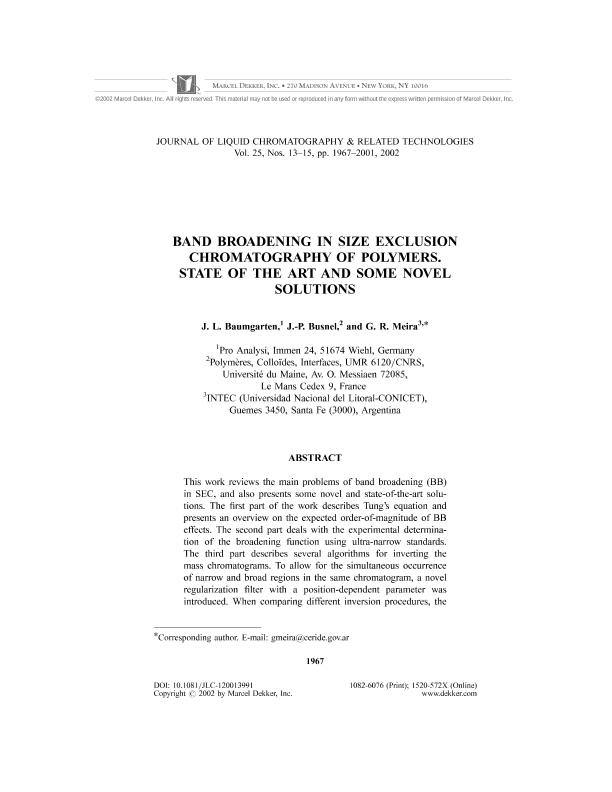Mostrar el registro sencillo del ítem
dc.contributor.author
Baumgarten, J.L.
dc.contributor.author
Busnel, J.P.
dc.contributor.author
Meira, Gregorio Raul

dc.date.available
2017-12-10T16:05:47Z
dc.date.issued
2002-12
dc.identifier.citation
Baumgarten, J.L.; Busnel, J.P.; Meira, Gregorio Raul; Band Broadening in Size Exclusion Chromatography of Polymers. State of the Art and Some Novel Solutions. 25th Anniversary Issue; Taylor; Journal of Liquid Chromatography and Related Technologies; 25; 12-2002; 1967-2001
dc.identifier.issn
1082-6076
dc.identifier.uri
http://hdl.handle.net/11336/30068
dc.description.abstract
This work reviews the main problems of band broadening (BB) in SEC, and also presents some novel and state-of-the-art solutions. The first part of the work describes Tung´s equation and presents an overview on the expected order-of-magnitude of BB effects. The second part deals with the experimental determination of the broadening function using ultra-narrow standards. The third part describes several algorithms for inverting the mass chromatograms. To allow for the simultaneous occurrence of narrow and broad regions in the same chromatogram, a novel regularization filter with a position-dependent parameter was introduced. When comparing different inversion procedures, the maximum entropy method has proven effective for recuperating structural details narrower than two times the width of the kernel. For broader and smoother regions, most other inversion procedures are equally effective. The fourth part of the work aims at producing unbiased estimates in multidetection SEC. For a derived variable obtained by linear combination of two or more chromatograms, it is preferable to directly perform the calculation from the raw measurements, and then to correct the (broadened) derived variable with the standard system kernel. When estimating molar masses from in-line molar mass sensors, intolerable errors are produced near to the baselines. To cope with this problem and to simultaneously correct for BB, a theoretical procedure is reviewed that is based on recuperating the linear (unbiased) molecular weight calibration.
dc.format
application/pdf
dc.language.iso
eng
dc.publisher
Taylor

dc.rights
info:eu-repo/semantics/openAccess
dc.rights.uri
https://creativecommons.org/licenses/by-nc-sa/2.5/ar/
dc.subject.classification
Otras Ingeniería Química

dc.subject.classification
Ingeniería Química

dc.subject.classification
INGENIERÍAS Y TECNOLOGÍAS

dc.title
Band Broadening in Size Exclusion Chromatography of Polymers. State of the Art and Some Novel Solutions. 25th Anniversary Issue
dc.type
info:eu-repo/semantics/article
dc.type
info:ar-repo/semantics/artículo
dc.type
info:eu-repo/semantics/publishedVersion
dc.date.updated
2017-11-24T13:44:16Z
dc.journal.volume
25
dc.journal.pagination
1967-2001
dc.journal.pais
Estados Unidos

dc.journal.ciudad
New York
dc.description.fil
Fil: Baumgarten, J.L.. Pro Analysi; Alemania
dc.description.fil
Fil: Busnel, J.P.. Universite du Maine; Francia
dc.description.fil
Fil: Meira, Gregorio Raul. Consejo Nacional de Investigaciones Científicas y Técnicas. Centro Científico Tecnológico Conicet - Santa Fe. Instituto de Desarrollo Tecnológico para la Industria Química. Universidad Nacional del Litoral. Instituto de Desarrollo Tecnológico para la Industria Química; Argentina
dc.journal.title
Journal of Liquid Chromatography and Related Technologies

dc.relation.alternativeid
info:eu-repo/semantics/altIdentifier/doi/http://dx.doi.org/10.1081/JLC-120013991
Archivos asociados
